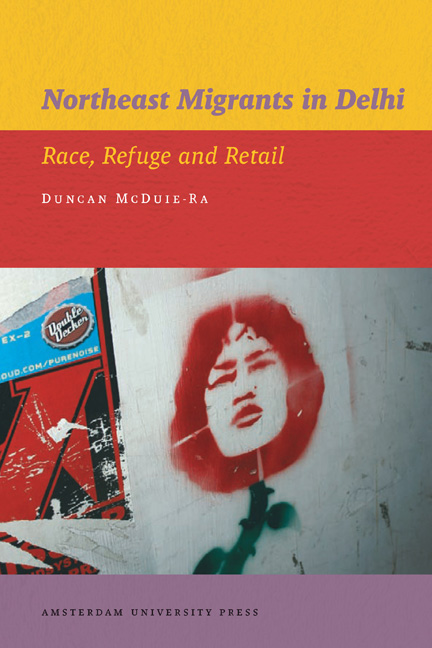Book contents
- Frontmatter
- Contents
- List of Maps and Images
- Acknowledgements
- Maps
- 1 Introduction
- 2 Leaving the Northeast
- 3 Coming to Delhi
- 4 Backward, Head-hunter, Sexy, Chinky
- 5 Provincial Men, Worldly Women
- 6 Place-making in the City
- 7 Conclusion
- Short Biographical Note on the Author
- Bibliography
- Index
- Publications Series
- Frontmatter
- Contents
- List of Maps and Images
- Acknowledgements
- Maps
- 1 Introduction
- 2 Leaving the Northeast
- 3 Coming to Delhi
- 4 Backward, Head-hunter, Sexy, Chinky
- 5 Provincial Men, Worldly Women
- 6 Place-making in the City
- 7 Conclusion
- Short Biographical Note on the Author
- Bibliography
- Index
- Publications Series
Summary
On a January evening in Humayanpur, a neighbourhood in south Delhi, three young men from Nagaland in baggy jeans, coloured sneakers and spiky hair – one with dyed highlights – inspect vegetables from a mobile vendor in the narrow alleyway outside the entrance to their stairwell. From a window five floors up, another Naga calls out for them to hurry up because he has already started cooking. The vegetable vendor begins negotiations in English, touting the quality of his egg-plants. One of the Nagas starts speaking to the vendor in Hindi, telling him not to bother trying to overcharge them. They live upstairs and will be buying vegetables every day. The vendor chuckles, and jokes that he has never heard such bad Hindi but is happy to know he has new customers. The next morning a dozen young men and women wait at the main gate of the same neighbourhood in the Delhi fog. The men wear the jeans and sneaker combination while the women wear ensembles of leggings, cardigans, and skirts. They chat to each other in Mizo, Nagamese, and English while waiting to be picked up by a minibus that will drive them to their shift at a call centre in a corporate park in the satellite city of Gurgaon. Later that day in the brand new shopping mall in nearby Vasant Kunj, a trio of women from Manipur serve chicken burgers and fries in an Americana-styled restaurant. Dressed in a uniform of a black polo shirt and black pants with their hair tied up and generous applications of eyeliner, they move around the tables with oversized menus and answer frequent questions about the content of the meals. One of the customers, a foreign tourist, speculates with her companion as to whether they are migrant workers from China.
All over Delhi, Bangalore, and Mumbai, similar scenes are being played out with increasing regularity. Contemporary Indian metropolises are experiencing a rapid increase in migration from frontier areas, including large numbers of migrants from the Northeast region. This is significant given that migration involves engagement with the people and places of the Indian heartland, which clashes with the anti-India underpinnings of social and political life in the Northeast.
- Type
- Chapter
- Information
- Northeast Migrants in DelhiRace, Refuge and Retail, pp. 13 - 34Publisher: Amsterdam University PressPrint publication year: 2013



